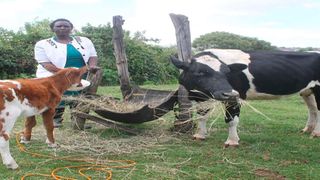
Linet Cherono on her dairy farm in Elburgon, Nakuru County.
Seeds of Gold
Premium
Know what a cow’s dung says about its health
Lynda McDonald is the project manager, dairy development at Tetra Laval Food for Development, an institution that promotes the dairy value chain. She spoke to Stanley Kimuge on how livestock farmers can monitor the health of their animals just by looking at the manure.

Project manager, dairy development at Tetra Laval Food for Development Lynda McDonald.
Why should farmers always pay attention to animal droppings?
The manure is a problem-solving tool as it helps one to understand animal health in relation to diet and nutrition. Through it, one is able to analyse the quality of feeds given to animals vis a vis the products, in this case, meat, milk and manure. One can then use the information as a diagnostic tool to better understand the health of their animal.
Tell us what manure scoring is and what does it entail?
Manure scoring is the art and science of analysing cow dung. Basically, it helps to know what is good or bad for the animal. For an expert like me, the first thing I do when I visit a farm is to look at the shape and the size of the manure, is it tall or flat? Second, I look at the consistency and the colour, is it dry or very wet? We have a manure score chart, which runs from one to five.
One being runny and thin and five being dry and crummy. Then we look for other indicators like parasites, bubbles, mucus or oil in the manure. Using this system, we use manure as a tool to understand if there is too much or too little protein in the feed ration, too much or too little fibre, and to better understand the general health of the digestive system.
Explain to the ordinary farmer what is the ideal cow dung
The ideal cow dung should not be too thick or too thin (manure score of three). If you are feeding grains to a dairy cow, and you see them in the dung, that is waste of money. This shows that the grain is not being broken down in the rumen. That could be because of two reasons: First, the grains are not being cracked well at the time of harvesting – they must be cracked to allow the rumen microbes access to the starch inside to be able to digest it fully.
Second, the rumen digestion is not optimal. You can solve this by either adjusting the corn kernel machine in the feed mill to crack the grains properly or by ensuring that the rumen is optimally fermenting and able to digest the grains.
If there are bubbles in the manure, this is an indication that the animal has an acidosis problem in the rumen. If there is mucus in the dropping, this is an indication of less fibre in the diet or there is a pathogen in the gut that needs to be investigated.
Smelly manure is a sign of illness (starch that is not digested increases odour-causing compounds such ammonia).
I like to use a model of a farm adviser being like a traditional Chinese medicine doctor. It is important to use all the senses when doing a farm analysis; brain to see the bigger picture, hands to touch, noses to smell the feeds and smells around the farm, eyes to see and mouth to ask questions, and ears to listen to the farmer’s responses. Manure scoring is one of the diagnostic tools we can use to rate an animal’s performance.
How regularly should a farmer monitor animal waste from their dairy cows?
It is important to conduct monitoring regularly. However, to get desired results, it depends on the extent of the problem. When the rumen pH is low and there is acidosis, you notice bubbles in the cow dung. From my work around Kenya, much of the silage given to animals is acidic. (It could also be an indication that many animals have an acidosis problem in the rumen).
One can solve this problem by mixing the silage with other feeds (dilution) or by using a sodium bicarbonate additive. This helps to lower the pH in the rumen.
Microbes function best in a stable rumen environment; that has a more neutral pH. It is also important to ensure the cow has enough clean fresh water at all time, microbes have a balanced diet of energy and nitrogen sources, and take time to transition the cow to new feeds or higher quantities. And lastly, understand that it can take up to 21days for the microbe populations to adjust.
If one detects an animal has a problem through its manure, is it safe to use any kind of dropping as manure on the farm?
Some manure carry diseases or pathogens excreted by animals such as clostridial and coliform bacteria. When it comes to pathogen control, it’s important to take a whole-farm approach.
Manage the dairy environment to limit animals’ exposure to harmful pathogens at every step of the operation, including manure handling, storage and application. Besides that, manure should not be applied directly to crops as soon as it is released. One should use it after about a month.
Does manure scoring system apply to other livestock like goats, pigs and chickens?
This concept can be used to assess all kinds of dairy cow breeds and at different ages. Though, I am not a pig or poultry expert, I believe this concept can be used to understand the health of all the livestock on a farm.





